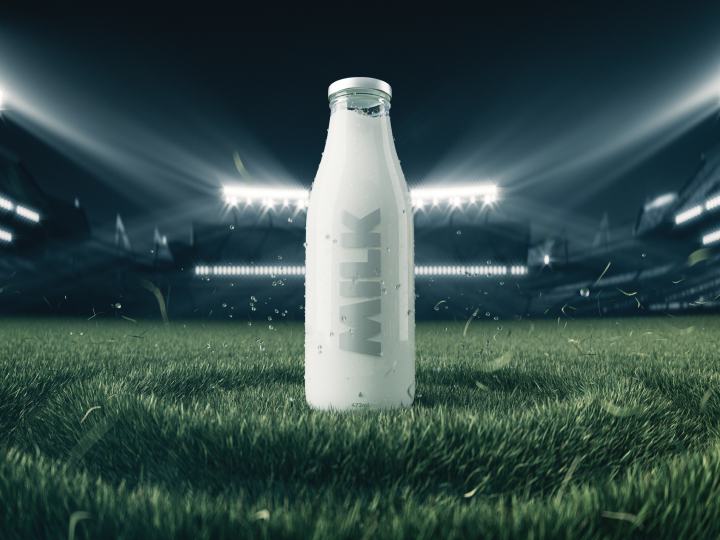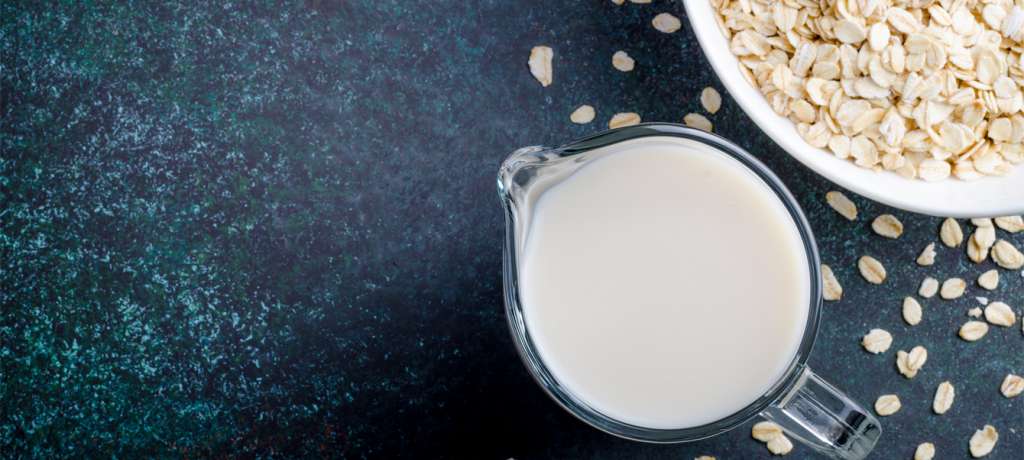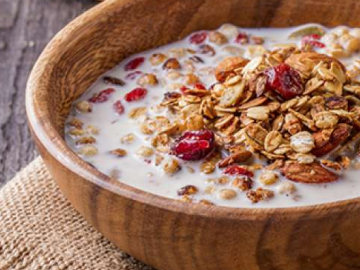Milk Vs. Almond Milk
When you make a smoothie or mix overnight oats, do you think about the differences between almond milk and milk? Depending on which beverage you choose, there are real differences on the nutrition labels to consider.
One difference to keep in mind when comparing almond milk and milk, is that real milk, including fat-free, flavored and organic, provides 8 times more naturally occurring, high-quality protein in every 8-ounce glass, and is one of the original farm-to-table foods, a wholesome and simple, minimally processed beverage.
Another thing to keep in mind is sugar. The Dietary Guidelines recommends limiting the amount of added sugar in your diet. Good news for milk lovers—regular white dairy milk has no added sugar. The sugar in white milk is lactose, which is a naturally occurring sugar. Many types of non-dairy milk, like almond milk, contain added sugar. Ingredients like cane sugar or cane juice on the ingredient list indicate that sugar has been added to the almond milk.
One reason why people may choose almond milk is because they believe it has a significant amount of almonds in every serving. But how many almonds are in a glass of almond milk? Many brands of almond milk may contain as little as two percent almonds, (which is the equivalent of three to four whole almonds in each 8-ounce glass) as calculated from data from the USDA Nutrient Database. This is determined by the amount of protein almonds contain—which explains the percentage of almonds to other ingredients in almond milk.
In addition, in many brands of both original and flavored almond milk there is often added sugar, as well as additives like lecithin and calcium carbonate, and added water.
Freezing Milk
If you want to save milk for later, you can—just freeze it in small containers (or an ice cube tray) before the expiration date. You’ll notice that milk (and almond milk as well) separates, and that’s completely normal. When you’re ready to use it, let it thaw in the refrigerator. Be sure to give it a quick shake and it’s ready to drink or use in your favorite recipes. If you want to save time in the morning, those frozen milk cubes have many uses, including adding them to your cold-brew iced coffee and smoothie recipes.
Want to know what’s in your glass or bowl? Here is how 8 ounces of fat-free milk compares to vanilla almond milk:
| Fat-free milk | Vanilla almond milk | |
|---|---|---|
| Calories | 80 | 90 |
| Protein | 8g (16% DV) | 1 g (2% DV) |
| Fat 0g 2.5 g | ||
| Carbohydrates | 12 g | 16 g |
| Total Sugar | 12 g (Includes 0 g added sugar) |
15 g (Includes 15 g added sugar) |
| Calcium | 300 mg (25% DV) | 450 mg (45% DV)* |
| Phosphorus | 250 mg (20% DV) | 19 mg (2% DV) |
| Riboflavin | 0.4 mg (35% DV) | 0.43 mg (25% DV)* |
| Pantothenic Acid | 0.9 mg (20% DV) | 0.02 mg (<1 % DV) |
| Vitamin B-12 | 1.2 mcg (50% DV) | 3 mcg (50% DV)* |
| Vitamin A | 500 IU (15%DV)* | 500 IU (10% DV)* |
| Vitamin D | 120 IU (15% DV)* | 100 IU (25% DV)* |
SOURCES:
U.S. Department of Agriculture, Agricultural Research Service. 2015. USDA National Nutrient Database for Standard Reference, Release 28.
USDA #01085; Milk, nonfat, fluid, with added vitamin A and vitamin D (fat free or skim)
USDA #14016; Beverages, almond milk, sweetened, vanilla flavor, ready-to-drink
Do Milk Alternatives Offer the Same Nutrition as Milk?
Not all non-dairy milks have the same nutrients as real milk, so it’s important to know how they compare.
Take a look at the label. Milk contains just three ingredients—milk and vitamins A and D. Dairy milk is a nutrient powerhouse, providing thirteen essential nutrients, including calcium and vitamin D—nutrients many Americans, including children, fall short of in their diets as described by the Dietary Guidelines for Americans.
Drinking cow’s milk is a simple way to increase your intake of these important nutrients that nutrition experts identify as “nutrients of public health concern” because Americans do not consume enough in their diets, and not getting enough of these nutrients is linked to health concerns.
The nutrients in many non-dairy milk beverages, like almond milk, soy milk and rice milk, are not the same as cow’s milk. In fact, few can match the full nutrient package found naturally in milk. For example, an 8-ounce serving of milk offers between seven to eight more grams of protein when compared to almond or coconut drinks, which helps build lean muscle and helps you feel full longer. While soy beverages contain minimal amounts of natural calcium, they are typically fortified—in some cases they may have as many as five fortified nutrients. Also, according to the American Academy of Pediatrics, milk is a great way for kids to get their bone-building nutrients—even more so than non-dairy milks fortified with calcium. For more on how their nutrient profiles stack up, check out this side-by-side comparison of dairy milk to a range of alternatives.
Case in point, a recent study found that milk alternatives might not give kids enough vitamin D when they replace dairy milk in the diet. Young children who drank only soy, almond or rice milk were more than twice as likely to be deficient in vitamin D, a key nutrient found in milk, as kids who drank only dairy milk. In fact, for every cup of non-dairy milk in the kids’ diets, their blood levels of vitamin D decreased by 5 percent.
The team of Canadian researchers who conducted the study suggests not all milks are created equal, and for non-dairy milks there “is little regulation on the vitamin D content even if such beverages are fortified.”
How Does Almond Milk Protein Stack Up to Milk’s Protein?
You may wonder how much protein is in rice milk, almond milk and coconut milk versus dairy milk. With 8 grams of protein in every 8-ounce glass, dairy milk has eight times more protein than almond milk and rice milk, which only have one gram of protein. Coconut milk has 0 grams of protein.
It’s important to remember that many plant-based protein sources are incomplete proteins. This means you may miss some of the building blocks our bodies need.
Real dairy milk is a natural source of high-quality protein, which is an evaluation based on the mix of amino acids (the building blocks of protein) and how easily it can be digested and absorbed. To be considered “complete,” a protein must contain all nine essential amino acids, which provides the full mix of essential amino acids our body needs. From muscles to hair, bones to teeth, the body needs protein to be healthy and strong.
Can You Drink Non-Dairy Milk Instead of Milk?
There’s just no substitute for milk. It’s naturally nutrient-rich like no other beverage.
Check your ingredient labels. Real milk is remarkably simple—milk, typically with added vitamin A and D, so you always know what you get when you pour a glass. Other non-dairy milk options often have more than 10 ingredients, including added salt and sugar, and stabilizers and emulsifiers like locust bean gum, sunflower lecithin and gellan gum. Such added ingredients in non-dairy milk can make you wonder: Is almond milk fattening? The added sugar and preservatives in some almond milk increase the calories and fat per serving while not delivering the calcium, vitamins A and D, and other nutrients found in dairy milk.
Other non-dairy milk options, like oat milk, are not readily available at most grocery stores. Plus, oat milk and other non-dairy milks, like almond milk, do not provide the same package of thirteen essential nutrients for the same price as dairy milk. At just about 25 cents per glass, milk offers more nutritional bang for your buck than just about any other beverage you can buy.
Non-dairy milk producers, like almond milk and rice milk, use different methods to fortify their products and there is no federal standard for these products on which nutrients they add or how much. All dairy milk provides the same thirteen essential nutrients, including high-quality protein, so unlike other non-dairy milks, you always know what you’ll get when you grab a glass of milk.
What Are the Health Benefits of Cow’s Milk?
An extensive body of research suggests far-reaching health benefits of cow’s milk. In fact, “intake of dairy products is also associated with a reduced risk of cardiovascular disease and type 2 diabetes, and with lower blood pressure in adults,” according to ChooseMyPlate.gov.
Cow’s milk is one of the original farm-to-table superfoods—a naturally nutrient-rich food, including B vitamins for energy, high-quality protein for lean muscle and bone-building nutrients, including calcium and phosphorus potassium.
No matter the type of cow’s milk you buy, from whole to reduced fat to fat-free to organic, each packs the same nutrient punch.




